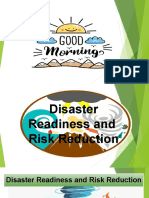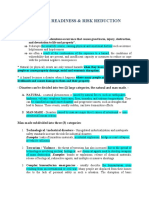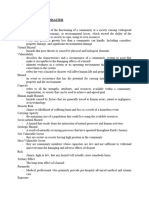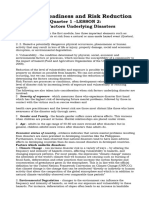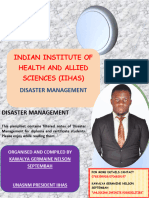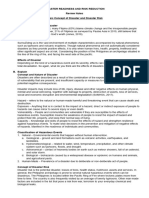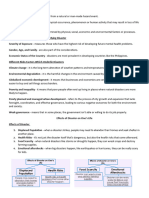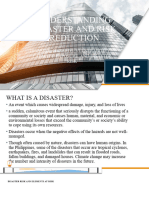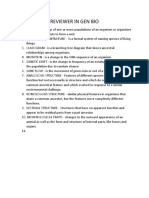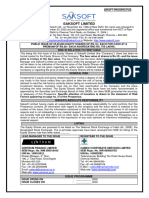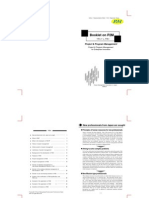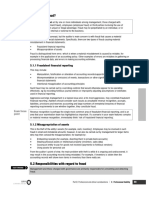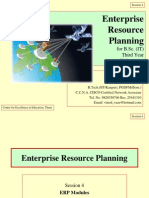0 ratings0% found this document useful (0 votes)
31 viewsReviewer in DRRR Imrm
Reviewer in DRRR Imrm
Uploaded by
Irish MaireignThe document discusses different perspectives on disasters including physical, psychological, socio-cultural, economic, political, and biological. It defines key terms like hazard, risk, vulnerability, capacity, and discusses how factors like climate change, environmental degradation, and poverty can influence disaster risk. Natural disasters are caused by natural forces while man-made disasters result from human actions, and both can have major human and economic impacts.
Copyright:
© All Rights Reserved
Available Formats
Download as DOCX, PDF, TXT or read online from Scribd
Reviewer in DRRR Imrm
Reviewer in DRRR Imrm
Uploaded by
Irish Maireign0 ratings0% found this document useful (0 votes)
31 views7 pagesThe document discusses different perspectives on disasters including physical, psychological, socio-cultural, economic, political, and biological. It defines key terms like hazard, risk, vulnerability, capacity, and discusses how factors like climate change, environmental degradation, and poverty can influence disaster risk. Natural disasters are caused by natural forces while man-made disasters result from human actions, and both can have major human and economic impacts.
Original Title
REVIEWER IN DRRR IMRM
Copyright
© © All Rights Reserved
Available Formats
DOCX, PDF, TXT or read online from Scribd
Share this document
Did you find this document useful?
Is this content inappropriate?
The document discusses different perspectives on disasters including physical, psychological, socio-cultural, economic, political, and biological. It defines key terms like hazard, risk, vulnerability, capacity, and discusses how factors like climate change, environmental degradation, and poverty can influence disaster risk. Natural disasters are caused by natural forces while man-made disasters result from human actions, and both can have major human and economic impacts.
Copyright:
© All Rights Reserved
Available Formats
Download as DOCX, PDF, TXT or read online from Scribd
Download as docx, pdf, or txt
0 ratings0% found this document useful (0 votes)
31 views7 pagesReviewer in DRRR Imrm
Reviewer in DRRR Imrm
Uploaded by
Irish MaireignThe document discusses different perspectives on disasters including physical, psychological, socio-cultural, economic, political, and biological. It defines key terms like hazard, risk, vulnerability, capacity, and discusses how factors like climate change, environmental degradation, and poverty can influence disaster risk. Natural disasters are caused by natural forces while man-made disasters result from human actions, and both can have major human and economic impacts.
Copyright:
© All Rights Reserved
Available Formats
Download as DOCX, PDF, TXT or read online from Scribd
Download as docx, pdf, or txt
You are on page 1of 7
REVIEWER IN DRRR
STUDY WELL GUYS!! MWEHEHE
WHAT THE DIFFERENT PERSPECTIVES OF IS DISASTER:?
1. Physical perspective
Calamities are phenomenais "a sudden, calamitous occurrence that
causecauses great harm, injury, destruction, and devastation to life and
property”
It disrupts the usual course of life, causing both physical and emotional
distress such as an intense feeling of helplessness and hopelessness.
Disasters are often a result of the combination of: the exposure to a hazard;
the conditions of vulnerability that are present; and insufficient capacity or
measures to reduce or cope with the potential negative consequences.
TWO ELEMENTS AFFECTED BY THE DISASTER:
life (whether human or animal)
property
effects vary – it maybe a minor damage (like broken windows and doors), major
damage (like torn rooftops, collapsed walls), total destruction.
CLASSIFICATION OF DISASTERS:
Disasters can be divided into 2 large categories:
Natural Disasters – a natural phenomenon is caused by natural forces, such
as earthquakes, typhoon, volcanic eruptions, hurricanes, fires,tornados, and
extreme temperatures.
Man-made - Disasters caused by man are those in communitywhich major
direct causes are identifiable intentional or non-intentional human actions .
SUBDIVIDED INTO THREE CATEGORIES:
Technological/industrial disasters - Unregulated industrialization and
inadequate safety standards increase the risk for industrial disasters.
Terrorism/Violence - the threat of terrorism has also increased due to the
spread of technologies involving nuclear, biological, and chemical agents used
to develop weapons of mass destruction.
Complex humanitarian emergencies – it is emergency resulting from an
international or civil war. In such situations, large numbers of people are
displaced from their homes due to the lack of personal safety and the
disruption of basic infrastructure, its people and their .
WHAT IS HAZARD?
a source or condition that has the potential to cause harm to humans in the
form of injury or illness, property damage, environmental damage, or a
combination of these.
WHAT IS DISASTER RISK?
refers to the potential disaster losses
the product of the possible damage caused by a hazard due to the
vulnerability within a community
IMPORTANT ELEMENTS
Exposure - the “elements at risk from a natural or man-made hazard event.
Hazard - a potentially dangerous physical occurrence, phenomenon or
human activity that may result in loss of life or injury, property damage, social
and economic disruption, or environmental degradation.
Vulnerability - the condition determined by physical, social, economic and
environmental factors or processes, which increase the susceptibility of a
community to the impact of hazard.
WHAT IS RISK FACTORS?
are processes or conditions, often development-related, that influence the
level of disaster risk by increasing levels of exposure and vulnerability or
reducing capacity.
The following are also taken into consideration when risk factors underlying
disaster are involved:
1. Severity of exposure - which measures those who experience disaster first
hand which has the highest risk to lowest risk.
2. Gender and Family - the female gender suffers more adverse effects. This
worsens when children are present at home.
3. Age - adults in the age range of 40-60 are more stressed after disasters but in
general, children exhibit more stress after disasters than adults do.
4. Economic status of country - it has been observed that natural disasters
tend to have more adverse effects in developing countries than do man
caused disasters in developed countries.
FACTORS WHICH UNDERLINED DISATER:
1. Climate Change - can increase disaster risk in a variety of ways – by altering
the frequency and intensity of hazards events, affecting vulnerability to
hazards, and changing exposure patterns.
2. Environmental Degradation - changes to the environment can influence the
frequency and intensity of hazards, as well as our exposure and vulnerability
to these hazards.
3. Globalized Economic Development - It results in an increased polarization
between the rich and poor on a global scale. Currently increasing the
exposure of assets in hazard prone areas, globalized economic development
provides an opportunity to build resilience if effectively managed.
4. Poverty and Inequality - Impoverished people are more likely to live in
hazard exposed areas and are less able to invest in risk-reducing measures.
The lack of access to insurance and social protection means that people in
poverty are often forced to use their already limited assets to buffer disaster
losses, which drives them into further poverty.
5. Poorly planned and Managed Urban Development - A new wave of
urbanization is unfolding in hazard-exposed countries and with it, new
opportunities for resilient investment emerge.
6. Weak Governance - weak governance zones are investment environments in
which public sector actors are unable or unwilling to assume their roles and
responsibilities in protecting rights.
WHAT IS THE DIFFERENCE BETWEEN HAZARD AND DISASTER?
A hazard is a dangerous situation or event that carries a threat to humans. A
disaster is an event that harms humans and disrupts the operations of society.
Hazards can only be considered disasters once it affected humans. If a
disaster happened in an unpopulated area, it is still a hazard.
THE HUMAN EFFECT OF NATURAL AND MAN-MADE DISASTERS
1. Displaced Populations
2. Health Risks
3. Food Scarcity
4. Emotional Aftershocks
WHAT IS VULNERABILITY?
Is a state being a risk.
refers to the characteristics and circumstances of people, community, system
or properties, e.g. houses and environmental sources of that increases the
chances of suffering from a disaster.
The characteristic of people or community can be described through
resilience. While circumstance can be identified through susceptibility.
a. Resilience. This refers to your ability to adjust and recover. Your ability
depends on your capacity, preparedness, and response.
b. Susceptibility. This refers to your proximity and exposure to a hazard.
Proximity means your physical closeness to a hazard zone.
Factors affecting vulnerability of one’s community:
1. Population density near a hazard event.
Population refers to the number of individuals inhabiting in a particular
space at the same time. If people are well distributed, there is lesser effect of
disaster.
Population density refers to the number of individuals living. in an area in
relation to the size of an area. If population density is high, it means that
the number of individuals is high but the space is very small.
2. Capacity and efficiency to reduce Disaster Risk.
Community that is less vulnerable has the capacity to reduce disaster risk because;
1. It can provide accessibility and availability of services and facilities
2. It has the ability to anticipate, adapt, and respond to possible disaster.
TERMS:
Capacity - refers to all resources utilized to handle an incident caused by a hazard
or to cope with the effects of a disaster. This includes skills, materials, and
organizations which will give you the needed recovery support.
Preparedness - are the actions taken before a disaster happens
Response - are the appropriate actions taken during or after a disaster
THERE ARE SEVERAL SECTORS IN THE SOCIETY WHICH ARE VULNERABLE
TO HAZARDS AND THE EFFECTS OF A DISASTER. These cited effects of a
disaster can be easily measured and the sectors are characterized by socio-
economic and demographic indicators.
Socio-economic Indicators. People who have low income, work usually in
agriculture or contractual job, and have low educational attainment are
vulnerable to disaster.
Low Income. People with low income tend to have limited resources. They
would not be able to buy the necessary things for disaster preparedness
because of their low income. Their lack of preparedness would lead to their
vulnerability to hazards.
Occupation. Agriculture and fishing have been largely the main source of
income to most commonFilipinos. Farming and fishing always face repeated
exposure to frequent typhoons, El Niño and La Niña. The extreme weather
conditions directly affect farmers to lose their crops.
2. Psychological Perspective
Victims of disasters may suffer from Post Traumatic Stress Disorder (PTSD)
and other serious mental health conditions, which are not being given much
attention to by the authorities or even by the victims, themselves.
3. Socio – cultural Perspective
Most Filipino families would rely on government’s help for them to get by.
However, limited resources and aids from the government make people find
possible ways to survive amid the pandemic.
4. Economic Perspective
Disasters affect the economic condition of a community because they reduce
local and international trade. It can also partially or totally paralyze a country’s
transportation system.
5. Political Perspective
Natural disasters are commonly thought to be less politically argumentative
than armed conflicts, yet a closer look shows that both the effects of a natural
disaster and the resulting distribution of humanitarian aid are profoundly linked
to politics.
6. Biological Perspective
The disturbing effects caused by a prevalent kind of disease or virus in an
epidemic or pandemic level is known as biological disaster.
(a) Epidemic Level: Biological disaster affects large numbers of people within
a given community or area. Ex: Dengue.
(b) Pandemic Level: Biological disaster affects a much large region, sometime
spanning entire continents or the globe
HAZARDS CAN BE CATEGORIZED IN DIFFERENT TYPES:
1. Natural hazards - arise from natural processes in the environment.
2. Quasi-natural hazards- arise through the interaction of natural processes and
human activities
3. Technological (or man-made) hazards- These arise directly as a result of
human activities.
THE DIFFERENT IMPACT OF HAZARDS:
1. Physical impact
2. Psychological impact
3. Socio- cultural impact
4. Economic impact
5. Environmental impact
6. Biological impact
IDENTIFICATION OF HAZARDS AND RISK ASSESSMENT
Hazard identification - is the process of determining all physical and
nonphysical agents in the workplace or specific environment.
Risk assessment - is a way to determine which hazards and risks should be
prioritized by taking into consideration the probability and severity of impact.
Below are the steps in hazard identification and risk assessment.
1. Identify the hazards
2. Assess the risk
3. Make the changes
Checking the changes madeEducational Attaintment. Having a low
educational attainment deprives a person of job opportunities with better
income to support oneself for essential needs.
Demographic Indicators. Young people, aging people, pregnant women,
undernourished people, and people with pre-existing medical conditions are
mainly vulnerable to the effects of a disaster.
Young people. These group of people commonly characterized by having a
developing immune system, limited knowledge about disaster preparedness,
limited skills to survive, and little experience of disaster situation.
Aging People. These people are aged 60 and above. Getting old is not really
a factor to be vulnerable. It is the health conditions that people in this age
group experience that makes them vulnerable to disaster.
Pregnant women. Their added weight may limit them to move quickly
especially during an emergency making them vulnerable to physical hazard.
People with pre-existing medical conditions. If they would not be able to
access the needed medicines and health care, they would be vulnerable to
health hazards. Their condition also weakened their immune system making
them vulnerable to infectious diseases.
Irish Maireign R. Magpantay
WHAT ARE EARTHQUAKE HAZARDS?
Earthquake Hazards refer to earthquake agents which have the potential
to
cause harm to vulnerable targets
The effects of an earthquake can be classified as primary or secondary.
• Primary effects are permanent features an earthquake can bring out.
• Secondary effects happen when ground movement results to other
types of destruction.
WHAT ARE THE NATURAL SIGNS OF AN IMPENDING
TSUNAMI?
1. Feel an earthquake. Severe ground shaking from local earthquakes may
cause tsunamis. However, an earthquake may not be felt if the event is far
away.
2. See ocean water disappear from beach, bay, river. Water may recede from
the coast, exposing the ocean floor, reefs and fish before returning as a fast-
moving wall of water (tsunami). This is called “drawback.” Drawback can
exceed hundreds of meters exposing normally submerged areas.
3. Hear an unusual roaring sound. Abnormal ocean activity, a wall of water,
and an approaching tsunami can create a loud "roaring" sound similar to that
of a train or jet aircraft.
Volcanic hazards are observable facts that are arising due to volcanic activity such
as eruption. Volcanic eruption is one of the dangerous event that may
happen because it results to different hazards such as: Ballistic projectiles,
Ash fall, Pyroclastic flows, Lava flows, Volcanic gases, Debris Avalanche or
Volcanic landslide and even Tsunami.
You might also like
- Suti The Psychology of MoneyDocument38 pagesSuti The Psychology of Moneyratalio winnerNo ratings yet
- MS 5.0 (1) Risk Assessment Project - Hardware Fitting On PoleDocument2 pagesMS 5.0 (1) Risk Assessment Project - Hardware Fitting On Poleraj86% (7)
- Seaoil Philippines, Incorporated Screening Tool For Management Trainee ApplicantsDocument2 pagesSeaoil Philippines, Incorporated Screening Tool For Management Trainee Applicantsleojay24No ratings yet
- Report of Pubali Bank On Credit Risk ManagementDocument68 pagesReport of Pubali Bank On Credit Risk ManagementMohammad Raihanul HasanNo ratings yet
- Handout DRRR 2024 - G12stemDocument6 pagesHandout DRRR 2024 - G12stemNatalie Dela Cruz OngsiakoNo ratings yet
- DRRR Week 1 - Hand-OutsDocument6 pagesDRRR Week 1 - Hand-OutsRogesa Marie Taboada BatiancilaNo ratings yet
- UntitledDocument50 pagesUntitledRaden PaulyneNo ratings yet
- DRRR Lesson 2Document16 pagesDRRR Lesson 2romeotamor7No ratings yet
- DRR ReviewerDocument10 pagesDRR ReviewerVeronica Hycinth SabidoNo ratings yet
- Disaster Readiness and Risk Reduction Lesson 1Document17 pagesDisaster Readiness and Risk Reduction Lesson 1maruhomjohanaaaNo ratings yet
- Disaster Readiness and Risk Reduction M2Document16 pagesDisaster Readiness and Risk Reduction M2Lara Ann CaringalNo ratings yet
- DRRR ReviewerDocument17 pagesDRRR ReviewerJohn Lloyd RaponNo ratings yet
- DRRR ReviewerDocument12 pagesDRRR ReviewerJohn Lloyd RaponNo ratings yet
- DRR Lesson 2Document23 pagesDRR Lesson 2Diana Hernandez100% (1)
- How 2 Study DRRRDocument8 pagesHow 2 Study DRRRdeoandreibocoNo ratings yet
- Disaster Readiness and Risk Reduction 1and 2Document8 pagesDisaster Readiness and Risk Reduction 1and 2dianapanaga20No ratings yet
- DRRM Module 1Document10 pagesDRRM Module 1elma anacletoNo ratings yet
- DRRR NotesDocument8 pagesDRRR Notescloud kumoishNo ratings yet
- BCS DRRR 01Document4 pagesBCS DRRR 01Christine Nicole CastroNo ratings yet
- Disaster Is "A Sudden, Calamitous Occurrence That Causes Great Harm, InjuryDocument12 pagesDisaster Is "A Sudden, Calamitous Occurrence That Causes Great Harm, InjuryRalph Louis RosarioNo ratings yet
- Basic Concepts of Disaster: MeaningDocument12 pagesBasic Concepts of Disaster: MeaningMariel VillaNo ratings yet
- DRRR ReviewerDocument3 pagesDRRR ReviewerSheena DumayNo ratings yet
- DRR (M1-2)Document3 pagesDRR (M1-2)Veneza LibaNo ratings yet
- Drrr-Lesson-2 2Document2 pagesDrrr-Lesson-2 2corteztricia45No ratings yet
- Handout DRRRDocument12 pagesHandout DRRRAbigail MejiaNo ratings yet
- DRRR D2Document27 pagesDRRR D2janlyn lumainoNo ratings yet
- Disaster Management Updated KawalyaDocument58 pagesDisaster Management Updated KawalyakyarimpaevelynvilantaNo ratings yet
- Disaster Readiness and Risk Reduction: Mr. Pepito P. SalibaDocument49 pagesDisaster Readiness and Risk Reduction: Mr. Pepito P. SalibaNorman Jr. Jazul100% (2)
- Disaster Readiness and Risk Reduction ReviewerDocument2 pagesDisaster Readiness and Risk Reduction ReviewerHyana Imm MedalladaNo ratings yet
- DISASTER READINESS Powerpoint 2Document28 pagesDISASTER READINESS Powerpoint 2Hazel Jean GaudicosNo ratings yet
- Chapter One What Is Disaster: Learning ObjectivesDocument8 pagesChapter One What Is Disaster: Learning ObjectivesDare RedevilNo ratings yet
- DRRRDocument26 pagesDRRRJemimah FV100% (1)
- Risk Factors Underlying DisastersDocument27 pagesRisk Factors Underlying DisastersAngelyn AbuevaNo ratings yet
- Differentiating Risk Factors Underlying Disaster LectureDocument3 pagesDifferentiating Risk Factors Underlying Disaster LectureChan PonceNo ratings yet
- DRRR Q3 ReviewerDocument14 pagesDRRR Q3 ReviewerAira MoscosaNo ratings yet
- DisasterDocument38 pagesDisastersostine wakoliNo ratings yet
- DRRR Module 4 5Document4 pagesDRRR Module 4 5kellan lyfeNo ratings yet
- DRRR Review NotesDocument13 pagesDRRR Review NotespronykibacolongNo ratings yet
- DRRR11 Q1 Mod3Document12 pagesDRRR11 Q1 Mod3Lany T. Catamin83% (6)
- DRRR w2Document7 pagesDRRR w2Kimberly Izza AlientoNo ratings yet
- DRRR Mod 1 & 2Document5 pagesDRRR Mod 1 & 2Jazmin CruzNo ratings yet
- Module 1Document35 pagesModule 1Paul Jean MerinoNo ratings yet
- DRRR ReviewerDocument7 pagesDRRR ReviewerJules Kirsten RueloNo ratings yet
- Altura E-Notebook DRRRDocument6 pagesAltura E-Notebook DRRRrolando5.alturaNo ratings yet
- Microsoft Word - Disaster - Prev - FMDocument9 pagesMicrosoft Word - Disaster - Prev - FMshivakumar1120skNo ratings yet
- Bascic Concept of Disaster and Disaster RiskDocument6 pagesBascic Concept of Disaster and Disaster RiskRicha Jane PilarNo ratings yet
- DRRRDocument5 pagesDRRRjames.raphael.reyes24No ratings yet
- Basic Concept of Disaster and Disaster Risk: Prepared By: Mateo T. Tadong, LPTDocument19 pagesBasic Concept of Disaster and Disaster Risk: Prepared By: Mateo T. Tadong, LPTElia Saph MoonNo ratings yet
- JagasDocument3 pagesJagasJasper MijaresNo ratings yet
- Q1 L2 DRRR HandoutsDocument1 pageQ1 L2 DRRR Handoutsangelafhayesantos613No ratings yet
- Drr-Lesson 1 - Basic Concept of Disaster and Diasaster RiskDocument7 pagesDrr-Lesson 1 - Basic Concept of Disaster and Diasaster Riskbelle.tan1105No ratings yet
- Lesson2 DRRDocument34 pagesLesson2 DRRNicole Abao AmanoNo ratings yet
- DRRR Week 1-5Document10 pagesDRRR Week 1-5alleanadelrosario.06No ratings yet
- DRRR Lesson 1Document31 pagesDRRR Lesson 1Juddielyn GalutanNo ratings yet
- Joey Boy Mission - DRRR - MODULE NEW TEMPLATE - Q1 - M1W1 PDFDocument2 pagesJoey Boy Mission - DRRR - MODULE NEW TEMPLATE - Q1 - M1W1 PDFChimmy Changa100% (1)
- Lesson 2-Risk Factors Underlying DisastersDocument25 pagesLesson 2-Risk Factors Underlying Disastersjhondee lagramaNo ratings yet
- DRRR Notes Aguino SentDocument28 pagesDRRR Notes Aguino SentALAJIAH CRUZNo ratings yet
- Disaster Risk Reduction: Effect of Disasters On One's LifeDocument2 pagesDisaster Risk Reduction: Effect of Disasters On One's LifeMary50% (2)
- DRR 3Document2 pagesDRR 3Cristine Marie MuyotNo ratings yet
- Arsheen Audit ReportDocument38 pagesArsheen Audit Reportayankhan1516No ratings yet
- UntitledDocument7 pagesUntitledLen ShaoxiNo ratings yet
- Understanding Disaster and Risk ReductionDocument31 pagesUnderstanding Disaster and Risk ReductionJamillah KanakanNo ratings yet
- DR ReviewDocument1 pageDR ReviewStarLightNo ratings yet
- Community Emergency Management, Disaster Recovery and ResilienceFrom EverandCommunity Emergency Management, Disaster Recovery and ResilienceNo ratings yet
- Parts and Function of MicroscopeDocument2 pagesParts and Function of MicroscopeIrish MaireignNo ratings yet
- Annelida Written ReportDocument11 pagesAnnelida Written ReportIrish MaireignNo ratings yet
- The Different Perspectives of DisasterDocument3 pagesThe Different Perspectives of DisasterIrish MaireignNo ratings yet
- ANNELIDADocument34 pagesANNELIDAIrish MaireignNo ratings yet
- Reviewer in Gen BioDocument1 pageReviewer in Gen BioIrish MaireignNo ratings yet
- Prospect UesDocument149 pagesProspect Uesmeghavichare786No ratings yet
- Social Protection For Development A Review of DefinitionDocument23 pagesSocial Protection For Development A Review of DefinitionTeddy LesmanaNo ratings yet
- IIA CIA PART1 DemoDocument16 pagesIIA CIA PART1 DemoVinayaNo ratings yet
- P2M BookletDocument20 pagesP2M BookletAkaninyeneNo ratings yet
- L4M6 Summarised Note RevisedDocument8 pagesL4M6 Summarised Note Revisedfaysal7No ratings yet
- Flood Risk Management. (Sop and RRL)Document5 pagesFlood Risk Management. (Sop and RRL)gracieNo ratings yet
- Risk Management (2) UpdatedDocument21 pagesRisk Management (2) Updatedthebackbenchers0623100% (1)
- RM Finals ReviewerDocument7 pagesRM Finals ReviewerErika May EndencioNo ratings yet
- Level 5 5013v1 Exemplar Assignment 2 For WebsiteDocument5 pagesLevel 5 5013v1 Exemplar Assignment 2 For WebsiteKareemAdams902950% (2)
- RRL-The Increasing Use of Digital ShoppingDocument14 pagesRRL-The Increasing Use of Digital ShoppingSittie Haliza C. MacmodNo ratings yet
- Preparing To The Financial Risk Manager FRM Certification Part Ii of GarpDocument4 pagesPreparing To The Financial Risk Manager FRM Certification Part Ii of GarpDALHI2014No ratings yet
- NIS 2 Directive and ISO 27001 - 2022, v.2.0Document9 pagesNIS 2 Directive and ISO 27001 - 2022, v.2.0j.correiaNo ratings yet
- Considerations For Business and Risk Managers During The Coronavirus/Covid19 OutbreakDocument19 pagesConsiderations For Business and Risk Managers During The Coronavirus/Covid19 OutbreakChristine MagnayeNo ratings yet
- Introduction To EthicsDocument11 pagesIntroduction To EthicsNurun NabiNo ratings yet
- 12B (Fraud) (Done)Document3 pages12B (Fraud) (Done)Abdul ToheedNo ratings yet
- Mental Health and Wellbeing PolicyDocument7 pagesMental Health and Wellbeing PolicyAjit SinghNo ratings yet
- ERP ModulesDocument41 pagesERP ModulesAmit Singh100% (2)
- RCGP NSPCC Safeguarding Children ToolkitDocument223 pagesRCGP NSPCC Safeguarding Children ToolkitMirela Cojocaru Stetco100% (1)
- Travel - Overseas Businessl Risk AssessmentDocument7 pagesTravel - Overseas Businessl Risk Assessmentapuesto726No ratings yet
- Creighton Professor Asks University To Grant Religious Exemptions For COVID Vaccine Mandate.Document5 pagesCreighton Professor Asks University To Grant Religious Exemptions For COVID Vaccine Mandate.The College FixNo ratings yet
- 12039-Flint Water Crisis-EODocument7 pages12039-Flint Water Crisis-EOelisha oketchNo ratings yet
- DNV - GL - Tracker - Bankability - White - Paper - 17-07-2018 3Document11 pagesDNV - GL - Tracker - Bankability - White - Paper - 17-07-2018 3brunoNo ratings yet
- Part 4 Business Ethics Sedex Supplier WorkbookDocument38 pagesPart 4 Business Ethics Sedex Supplier WorkbookIsahí Ugalde Gómez100% (1)
- Glass and Glazing Federation Standard ForDocument17 pagesGlass and Glazing Federation Standard Fors_omeone4usNo ratings yet
- Chapter 20 Audit of GICDocument50 pagesChapter 20 Audit of GICTarun BhardwajNo ratings yet
- Course Outline - OSH & HIRARCDocument4 pagesCourse Outline - OSH & HIRARCjustine8448No ratings yet






